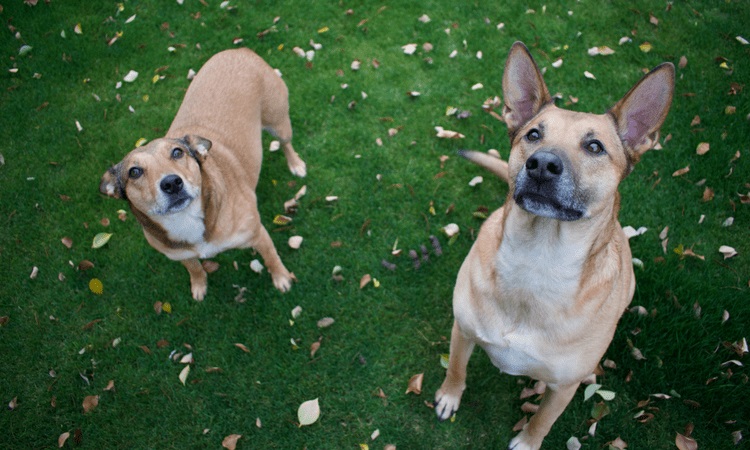As dog owners, we’ve all experienced that awkward moment when our furry friend decides to hump our arm. It can leave us feeling confused and maybe even a little uncomfortable. But why do dogs do this? Is it a sign of dominance or something else entirely? In this blog post, we’ll delve into the reasons behind this behavior and uncover the truth about why dogs hump arms.
Humping is a natural behavior for dogs, and it can have various meanings. Some people believe it’s solely an act of dominance, but that’s not always the case. Dogs may also hump as a way to show affection or seek attention from their owners. It could also be a form of play or excitement, especially in younger dogs who are still learning appropriate social behaviors.
Contrary to popular belief, female dogs can also exhibit this behavior. Humping is not exclusive to male dogs, as many people assume. Both males and females can engage in this behavior for various reasons.
Understanding the context and body language of your dog is crucial in determining the reason behind their humping behavior. Pay attention to their body posture and any other signals they may be giving off before jumping to conclusions.
Now that we’ve piqued your interest, let’s dive into the fascinating world of why dogs hump arms. We’ll explore different theories and provide helpful tips for managing this behavior in your furry companion.
So, let’s get started.
Key Takeaways
Table of Contents
- Dogs may mount arms due to various reasons such as dominance, aggression, affection, or excitement.
- This natural behavior can be bothersome for humans if done excessively or in front of guests.
- Understanding the underlying reason and seeking guidance from a professional can help address this behavior.
- Providing sufficient exercise and mental stimulation, ignoring the behavior, redirecting attention, and neutering/spaying are effective ways to decrease mounting tendencies in dogs.
- A high-quality diet without artificial ingredients may also prevent increased urination and desire to mount.
Understanding Dog Humping Behavior
Different types of dog humping behavior can be observed, including playful and dominant humping. Although both involve mounting and thrusting, there are distinct differences between the two.
During playtime, dogs may exhibit playful humping, accompanied by other fun behaviors such as chasing, wrestling, and play-bowing. This type of humping is initiated to continue or initiate play and is not meant to be aggressive or dominant. It is a way for dogs to express their enthusiasm and energy.
On the other hand, dominant humping is a more serious behavior. It is used to assert dominance over another dog and can occur in instances where there is a power struggle between two dogs or when one dog is trying to establish themselves as the alpha. Dominant humping may also be seen when a dog is feeling threatened or insecure.
There are key differences in body language and context that can help differentiate between playful and dominant humping. Playful humping is usually accompanied by a relaxed body posture, loose movements, and soft vocalizations. In contrast, dominant humping may involve a rigid body posture, stiff movements, and more intense vocalizations.
It’s crucial for dog owners to be able to recognize these differences in order to address the behavior appropriately. Punishing a dog for playful humping can actually reinforce the behavior by giving them attention they may be seeking.
Alternatively, addressing dominant humping with assertive leadership and proper training techniques can help establish a more balanced relationship between dogs.
Role of Hormones and Sexual Maturity
The role of hormones and sexual maturity is critical in a dog’s tendency to hump arms or other objects. During puberty, both male and female dogs undergo hormonal changes that can lead to mounting behaviors. This is due to the surge in testosterone levels among males and estrogen levels in females, which trigger reproductive instincts and behaviors.
Furthermore, as dogs reach sexual maturity, their interest in mating grows, and humping may serve as practice for future opportunities. Male dogs, in particular, are more susceptible to this behavior due to their strong reproductive drive.
However, it’s important to note that not all dogs will display humping behaviors during sexual maturity. Various factors such as genetics, environment, and past experiences can also influence a dog’s tendency to hump.
For instance, some dogs may use humping as a way to release excess energy or alleviate boredom, while others may do it to assert dominance.
Dog’s Emotions and Humping
A dog’s emotions can greatly influence their likelihood to hump arms. Feelings of anxiety, boredom, hormonal changes, and learned behaviors can all contribute to this innate behavior in dogs. By addressing these underlying emotions and triggers, pet owners can effectively manage and redirect their dog’s humping tendencies.
To better understand why dogs engage in this behavior, we must first explore the different emotions that can lead to it. Dogs are highly sensitive animals, and just like humans, they experience a wide range of emotions. These emotions can manifest in different ways, one of which is humping.
For example, if a dog is feeling anxious or stressed, they may turn to humping as a coping mechanism. This behavior can also be a result of boredom and excess energy, especially in more active breeds. Hormonal changes, such as an increase in testosterone levels, can also trigger this behavior in male dogs.
Furthermore, learned behaviors play a significant role in a dog’s tendency to hump. If a dog has been rewarded for humping in the past, they are likely to continue engaging in this behavior as it has been reinforced. This is why it’s crucial for pet owners to address this behavior early on and redirect it towards more appropriate outlets.
Medical Reasons Behind Humping
Humping is a natural and common behavior for dogs, and it doesn’t always indicate any underlying medical issues. However, there are certain medical reasons that may cause a dog to hump their owner’s arm, such as urinary tract infections (UTIs), prostate problems, testicular tumors, neurological disorders, allergies, pain, and hormonal imbalances. These medical conditions can lead to discomfort, irritation, and hormonal changes in dogs, which may result in excessive humping behavior.
UTIs can cause discomfort and irritation in dogs, leading them to hump objects or people as a way to find relief. Similarly, male dogs with prostate issues may experience an increase in testosterone levels, causing them to exhibit heightened humping behavior. Additionally, tumors in the testicles can disrupt hormone production and trigger increased humping.
Certain neurological disorders like epilepsy or brain tumors can also contribute to compulsive behaviors, including humping. Dogs with allergies may experience skin irritation and redness, causing them to resort to humping as a way to scratch and alleviate their discomfort. Similarly, dogs experiencing pain or discomfort from conditions like arthritis or injuries may use humping as a coping mechanism.
Not only intact males but also female dogs with hormonal imbalances may exhibit excessive humping behavior. If your dog repeatedly humps your arm or other objects, it’s crucial to consult a veterinarian. This will help rule out any underlying medical conditions and address them appropriately.
Humping as a Result of Boredom or High Energy
Causes of Humping as a Result of Boredom or High Energy:
Excitement and Play:
Dogs are highly energetic creatures and need an outlet for their boundless energy.
When they are bored or have pent-up excitement, they may resort to humping as a way to release it. This often happens during playtime when they are overstimulated.
Stress and Anxiety:
Just like humans, dogs can also experience stress and anxiety when they are not provided with enough mental and physical stimulation.
In these cases, humping can be a coping mechanism for their emotions.
Lack of Attention or Socialization:
If a dog has not been properly socialized as a puppy or does not receive enough attention from their owner, they may turn to humping as a way to seek attention or release their energy.
Medical Conditions:
As mentioned earlier, medical conditions such as UTIs, prostate problems, and hormonal imbalances can also contribute to humping behavior in dogs.
If your dog displays excessive humping, it is essential to consult a veterinarian to rule out any underlying health issues.
How to Address Humping Behavior:
Training and Boundaries:
Establishing boundaries and teaching your dog appropriate behaviors through training is crucial in addressing humping behavior.
Teaching them a “stop” command and redirecting their attention to a more suitable activity can help them understand what is acceptable behavior.
Ignore the Behavior:
If your dog is seeking attention through humping, ignoring the behavior can be an effective way to discourage it. This teaches them that this type of behavior will not get them the desired attention.
Provide Mental and Physical Stimulation:
Ensuring your dog receives enough mental and physical stimulation through exercise and training can also help reduce humping behavior.
This will provide an outlet for their energy and prevent them from resorting to humping as a coping mechanism for boredom or excess energy.
Consider Spaying/Neutering:
In some cases, spaying or neutering can also help decrease humping behavior in dogs.
This can help regulate their hormones and reduce their sexual drive, leading to less humping behavior.
Training Your Dog to Stop Humping
To effectively train your dog to stop humping your arm, it is crucial to understand the underlying reasons for this behavior. It could be due to boredom, high energy, or a lack of boundaries. Here are some strategies you can use to address this issue and train your dog to stop humping your arm.
- Identify the root cause: Take the time to observe your dog and try to determine why they are humping your arm. Is it because they are bored, seeking attention, or have excess energy? Understanding the underlying reason will help you address the behavior effectively.
- Ignore the behavior:v If your dog is humping your arm for attention, ignoring them can be an effective way to discourage the behavior. Turn away from them or leave the room, and do not give them any attention until they stop humping.
- Consider spaying or neutering: Humping can also be a result of sexual frustration or hormones, especially in unneutered males. Consider having your dog spayed or neutered to reduce their desire to hump.
- Redirect their attention: When you notice your dog starting to hump your arm, redirect their attention to a more appropriate activity such as playing with a toy or going for a walk.
- Implement a time-out: If redirection does not work, calmly remove your dog from the situation and place them in a quiet time-out space. This will help them calm down and break the behavior cycle.
- Teach obedience commands: Teaching your dog basic obedience commands like “leave it” can be helpful in stopping unwanted behaviors like humping. Practice these commands consistently and reinforce them with treats or praise when your dog obeys.
- Seek professional advice: If humping persists despite training efforts, it may be beneficial to consult a veterinarian or dog behaviorist for further guidance and advice.
- Use positive reinforcement: When your dog is playing calmly or engaging in appropriate behaviors, praise and reward them with treats. This will reinforce good behavior and discourage humping.
By implementing these strategies and consistently training your dog, you can effectively stop them from humping your arm.
When to Consult a Professional
When your beloved canine suddenly starts humping objects or people, it can be confusing and concerning. However, it is crucial to understand that this behavior is completely normal for both male and female dogs. Nonetheless, there may be certain instances where consulting a professional becomes necessary.
Some potential reasons for seeking professional assistance for your dog’s humping behavior could include:
- Excessive or persistent humping: If your dog’s humping seems out of control or continues for an extended period, it may be a sign of an underlying issue that requires attention. A professional can help identify the root cause and provide appropriate solutions.
- Aggressive humping: In some cases, humping can turn into aggressive behavior and lead to fights with other dogs. This type of behavior should be addressed immediately with the assistance of a professional.
- Underlying health issues: Humping can also be a symptom of underlying health problems such as urinary tract infections or hormonal imbalances. A veterinarian can provide accurate diagnosis and treatment for these conditions.
- Learned behavior: Dogs can pick up humping behavior from other dogs or their owners. If this is the case, a professional trainer can assist in modifying this behavior through positive reinforcement techniques.
Along with seeking professional help, there are steps you can take at home to discourage humping behavior in your dog. These include providing distractions, obedience training, and establishing boundaries in their environment.
Also Read: Why Do Dogs Bark At Certin People?
Conclusion
In conclusion, the act of a dog humping our arm may leave us feeling perplexed and uneasy.
However, it is a natural behavior for dogs that can have various meanings. It could be a display of dominance, affection, playfulness, or even a manifestation of boredom or pent-up energy.
Understanding the context and body language of our canine companions is crucial in deciphering the reason behind this behavior. By providing ample physical exercise and mental stimulation, ignoring the behavior when appropriate, redirecting attention to more suitable activities, and considering spaying/neutering, we can effectively manage humping tendencies in our furry friends.
With proper training and insight into our dog’s emotions and triggers, we can establish a harmonious relationship with our four-legged companions and address their humping behavior with understanding.






